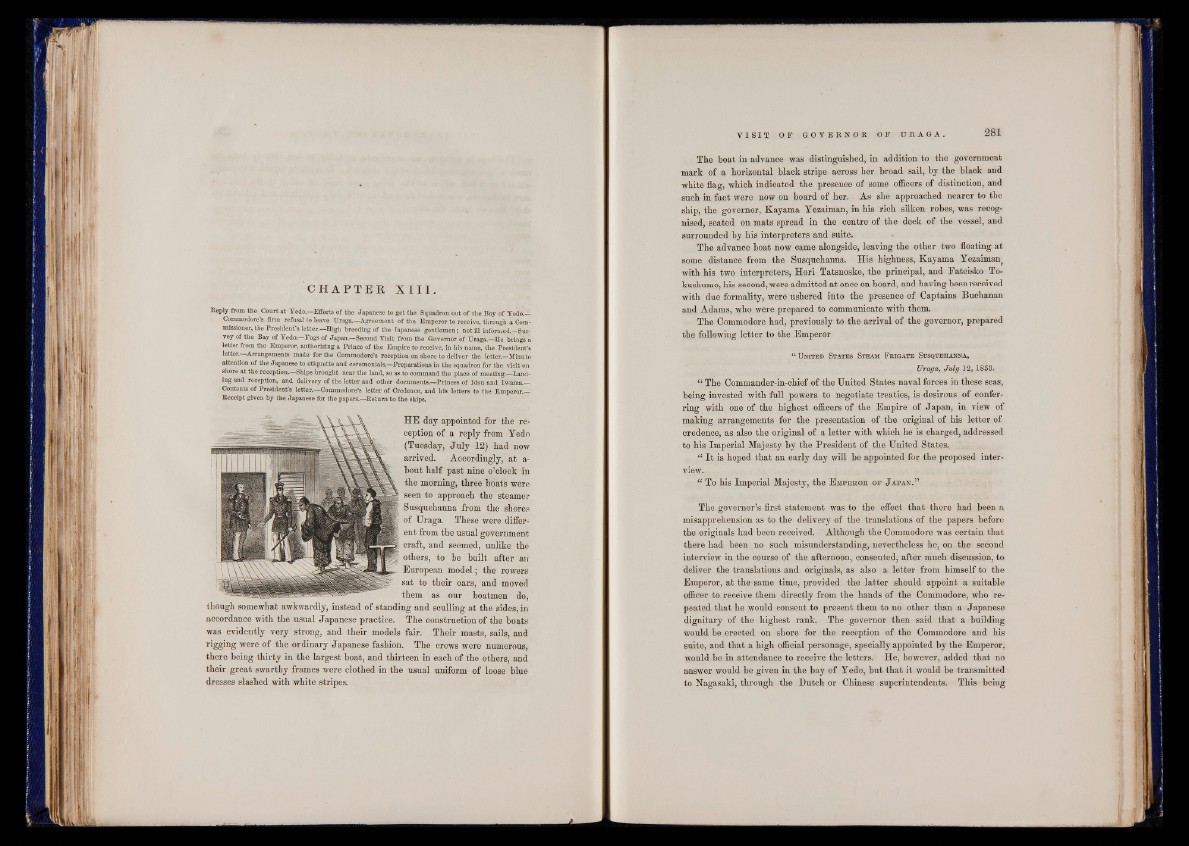
Reply from the Conrt at Yedo.—Efforts of the Japanese to get the Squadron out of the Bay of Yedo,—
Commodore’a - firm refusal to leave Uraga.—Agreement of the Emperor to receive, through a Commissioner,
the President’s letter.—High breeding of the Japanese gentlemen; not ill informed.—Survey
of the Bay of Yedo.—Fogs of Japan.—Second Visit from the Governor of Uraga.—He brings a
letter from the Emperor, authorizing a Prince of the Empire to receive, in his name, the President’s
letter. Arrangements made for the Commodore’s reception on shore to deliver the letter.—Minute
attention of the Japanese to etiquette and ceremonials,—Preparations in the squadron for the visit on
shore a t the reception.—Ships brought near the land, so as to command the place of meeting.—Landing
and reception, and delivery of the letter and other documents,—Princes of Idsu and Irvaina.—
Contents of President’s letter.—Commodore’s letter of Credence, and his letters to the Emperor,—
Beceipt given by the Japanese for the papers.—Return to the ships.
HE day appointed for the reception
of a reply from Yedo
(Tuesday, July 12) had now
arrived. Accordingly, at a-
bout half past nine o’clock in
the morning, three boats were
seen to approach the steamer
Susquehanna from the shores
of Uraga. These were different
from the usual government
craft, and seemed, unlike the
others, to be built after an
European model; the rowers
sat to their oars, and moved
them as our boatmen do,
though somewhat awkwardly, instead of standing and sculling at the sides, in
accordance with the usual Japanese practice. The construction of the boats
was evidently very strong, and their models fair. Their masts, sails, and
rigging were of the ordinary Japanese fashion. The crews were numerous,
there being thirty in the largest boat, and thirteen in each of the others, and
their great swarthy frames were clothed in the usual uniform of loose blue
dresses slashed with white stripes.
The boat in advance was distinguished, in addition to the government
mark of a horizontal black stripe across her broad sail, by the black and
white flag, which indicated the presence of some officers of distinction, and
such in fact were now on board of her. As she approached nearer to the
ship, the governor, Kayama Yezaiman, in his rich silken robes, was recognised,
seated on mats spread in the centre of the deck of the vessel, and
surrounded by his interpreters and suite.
The advance boat now came alongside, leaving the other two floating at
some distance from the Susquehanna. His highness, Kayama Yezaiman)
with his two interpreters, Hori Tatsnoske, the principal, and Eatcisko To-
kushumo, his second, were admitted at once on board, and having beenreceived
with due formality, were ushered into the presence of Captains Buchanan
and Adams, who were prepared to communicate with them.
The Commodore had, previously to the arrival of the governor, prepared
the following letter to the Emperor
“ U n it ed States Steam F b iu a t e Susquehanna,
TJraga, Ju ly 12, 1853.
H The Commander-in-chief of the United States naval forces in these seas,
being invested with full powers to negotiate treaties, is desirous of conferring
with one of the highest officers of the Empire of Japan, in view of
making arrangements for the presentation of the original of his letter of
credence, as also the original of a letter with which he is charged, addressed
to his Imperial Majesty by the President of the United States.
“ I t is hoped that an early day will be appointed for the proposed interview.
“ To his Imperial Majesty, the E m p e r o r o f J a p a n . ”
The governor’s first statement was to the effect that there had been a
misapprehension as to the delivery of the translations of the papers before
the originals had been received. Although the Commodore was certain that
there had been no such misunderstanding, nevertheless he, on the second
interview in the course of the afternoon, consented, after much discussion, to
deliver the translations and originals, as also a letter from himself to the
Emperor, at the same time, provided the latter should appoint a suitable
officer to receive them directly from the hands of the Commodore, who repeated
that he would consent to present them to no other than a Japanese
dignitary of the highest rank. The governor then said that a building
would be erected on shore for the reception of the Commodore and his
suite, and that a high official personage, specially appointed by the Emperor,
would be in attendance to receive the letters. He, however, added that no
answer would be given in the bay of Yedo, but that it would be transmitted
to Nagasaki, through the Dutch or Chinese superintendents. This being